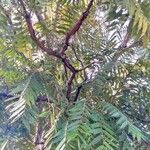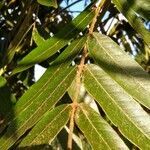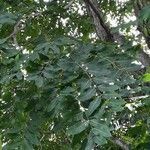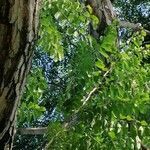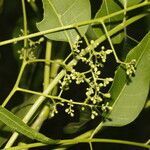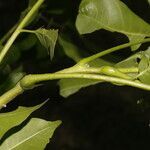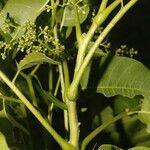Trees to 10 m tall. Branchlets glabrous, with sparse lenticels. Leaves 30 cm or more; leaflets 17 or 19; petiolules 1-1.5 cm; leaflet blades ovate, oblong, or elliptic, 8-12 × 3.5-4 cm, membranous, both surfaces glabrous, secondary veins 10-12 on each side of midvein and prominent on both surfaces, base rounded and oblique, margin entire or serrate, apex acuminate to acute. Thyrses shorter than leaves, glabrous, branches and branchlets slender. Flowers oblong to ellipsoid, small. Calyx 5-lobed, sparsely pubescent. Petals white, distinct, oblong to elliptic, ca. 8 mm, both surfaces pubescent, apex mucronate. Disk glabrous. Ovary glabrous, with 12 ovules per locule; style glabrous. Capsule oblong to ellipsoid, ca. 4 cm, glabrous, with pale lenticels. Fl. summer.
A tree. It grows 18 m high and spreads 4.5 m wide. The trunk can be 1.5 m across. It has large buttresses. It has an open canopy. The bark is grey or brown and furrowed. The lower limbs curve down. The leaves have leaflets along the stalk. The leaves are 60 cm long. There are 5-12 pairs of leaflets. The flowers are separately male and female but on the same plant. The flowers are small and tube shaped and cream or green. They are in hanging clusters at the ends of branches. The clusters are 15-50 cm long.
Tree up to 30 m. tall.. Leaflets usually 12 to 28, entire, oblong-lanceolate, up to 15 × 6.5 cm., rather suddenly tapered to the relatively short and broad acumen; proximal lateral nerves on lower surface with conspicuous elongate axillary pockets (domatia) with minute marginal hairs or glabrous.. Inflorescence up to 50 cm. long.. Capsule robust, usually 3–4.2 cm. long; valves with conspicuous lenticels.. Fig. 13/1–6.
Deciduous tree to 35(–60) m in wild. Leaves usually paripinnate, usually (5) 6–12 (–15)-jugate. Flowers creamy white, disagreeably scented, in thyrses to 40(–50) cm long. Stamens 5, free. Capsule with broadly 5-winged columella. Seeds 2–3 cm long, winged at one end.
